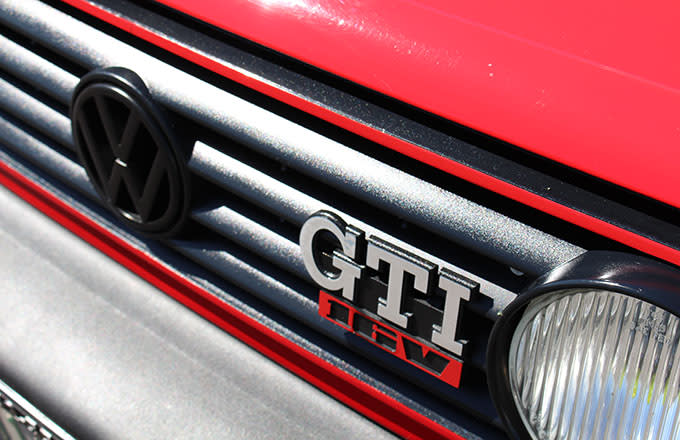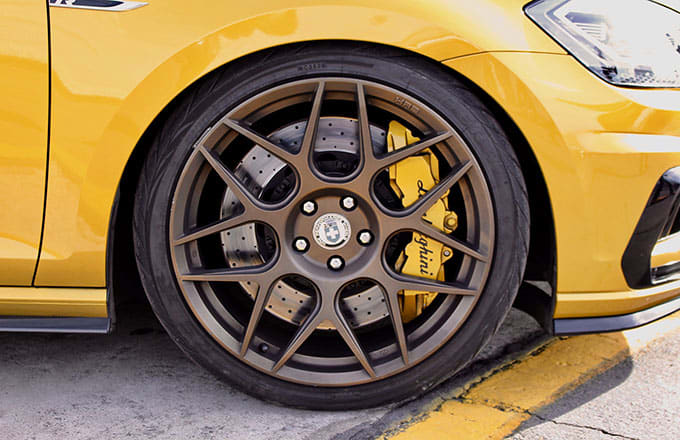
“That’s why he’s the president!” a friend interjected during my discussion with Jacobo Sahaguian. He was referring to Sahaguian’s enviable collection of 16 Volkswagen GTIs, which includes at least one version of each generation of the storied hot hatchback. Sahaguian is the leader of the GTI Club of Mexico, an officially backed group with members from all over the country. For the 11th time, the club held a track day at Autódromo Miguel E. Abed in Amozoc de Mota, just east of Puebla City, Mexico, where a few journalists were invited as guests to witness a strong and growing community of proud VW enthusiasts.
It wouldn’t be a stretch to call Puebla City the heart of Mexico’s Volkswagen culture. It is there, beneath ash-tinged air from Popocatépetl, a nearby active volcano, that Volkswagen runs its biggest factory outside of Germany. More than 14,000 employees at the 740-acre plant help to build the Tiguan, Jetta, Golf and Golf Estate, and the last examples of the Beetle. Since opening in 1964, it has produced more than 12,000,000 vehicles.
As the Beetle takes its last bow, it will be remembered as the car that started it all. Evidenced by the numerous old-school Bugs that still drive the streets of Puebla today, the Beetle quickly became a favorite, as it was the first car to come off the production line in Puebla.
“The first car in your mind when you had to select your first car was the Volkswagen Beetle,” PR Manager for VW Mexico Mauricio Gálvez said. “It was cheaper, it was bulletproof, and at the end, it was a practical car for every type of person.”

In addition to offering practicality at an affordable price, the Volkswagen brand represented a homemade product with premium European quality.
“It’s a German brand, but we have so many vehicles that are proudly made in Mexico, so it feels more Mexican,” Gálvez said. “It’s a near-luxury brand, so it’s super aspirational… People love these cars because of the technology, and Volkswagen’s spirit for performance is still the main difference from the other brands.”
This type of accessibility helped foster a relationship between the community and the brand.
“The factory, it’s in Germany, and it’s here in Puebla,” said Jesus Raul Sauder Loyola, who works at the VW plant and was at the event selling branded gear. “That makes all the people that live in Puebla like Volkswagen and like the GTI and the GLI. If you live in Puebla, you need a Volkswagen. It’s just like that.”
“When they were young, many people here start with a Beetle, then they turn to the Golf, then Jetta.” Galvez said. “So it’s many generations, and it’s part of the life here. They’re proud to be part of the Volkswagen family.”
The reputation for performance grew exponentially when VW launched what Gálvez called the first sports car for the young people of Mexico, the Golf GTI. But in Mexico, the Golf wasn’t always called the Golf, and the GTI wasn’t always called the GTI. After the Golf first launched in Europe, it debuted in multiple other markets under various monikers.

In the U.S., it was first the Rabbit. In South Africa, it was the CitiGolf, and in Mexico, it was called the Caribe. The Mark 1 Caribe didn’t receive the GTI treatment, either, as it was dubbed the Caribe GT, with the lack of the “I” an indication of a major difference under the hood. Whereas Golfs had direct injection fuel systems, the Caribe’s engine ran with a carburetor delivering fuel. Thus it could not be called a Grand Touring Injection, or GTI. Still, several pristine Caribe GTs were in attendance and drew some of the biggest crowds at the event.
This type of unique history is exactly what Sahaguian wants to preserve and celebrate with his club. The GTI Club of Mexico is the only club of its kind that is officially backed and supported by Volkswagen. In 1999, Sahaguian partnered with a friend who was selling 16V GTIs and started organizing monthly dinners for GTI fans in Mexico City. His only decree? That all club cars stay as close to stock form as possible.
“We try to look for original, but it’s very difficult because every person is different,” Sahaguian said. “Most of the time, when they buy a GTI, they want some wheels, they want a suspension, things like that. We keep on trying to convince our members that the original, classic look is the perfect look.”
There are now more than 100 members in the club, many of whom regularly meet for monthly gatherings and help each other find parts for cars to restore them. Yearly events, which are not restricted to members, are significantly bigger and draw people from cities hundreds of miles away, such as Monterrey, Guadalajara, Mexico City, and Cuernavaca.

Because the annual track meets are open to fans of all types, Caribes, Golfs, Polos, and Rabbits of all flavors lined the entrance, garages, and pits of the racetrack. Some had tires tucked neatly inside wheel wells, with bumpers barely high enough to drive over a pebble. Some had “VW Addicted” or “Low Static” or Nürburgring track outline stickers on their windows. Some had matte blood-red wraps; some had race-ready graphics and numbers; and some had Bentley, Audi, or Mercedes-Benz wheel swaps.
Possibly the most extravagant mod was a brake job. Body-matching bright metallic gold calipers popped behind Bronze HRE wheels. But it wasn’t the color that raised eyebrows—it was the signature cursive script. Somebody had installed Lamborghini brakes on a Golf R, the highest-performance Golf currently available. Another attendee who had installed Porsche brakes must have felt some type of way about being outdone.
But aside from some spirited driving on the short, technical Miguel E. Abed raceway, the event is less about competition and more about shared love. Inspired by GTI Treffen am Worthersee, a famous VW festival in Austria and one of the biggest auto enthusiast events in the world, the GTI Club of Mexico adopted the slogan “Passion. Friends. Family.” for the event.
Edgar Sanchez, a mechanic and racecar driver who was one of the original members of the club (Sahaguian was his neighbor), got into GTIs because his father owned one. He owns two ’80s GTIs, a ’90 Jetta, a ’76 Bug, and an ’02 Audi A4, and noted all of his brothers own various Volkswagens, as well.

“This kind of club is one of the first [of its kind] and is important in Mexico because every car is perfect,” Sanchez said, referring to the requirements of membership.
The respect for all generations of the car was evident everywhere you looked. Volkswagen and GTI hats and shirts littered the crowds. Tents kept families out of the sun while they ate, drank, and enjoyed the day off on a Friday afternoon. Couples perused the lineups of classic and custom cars, while new and old friends traded stories over engine bays. There was even a playground behind lifesize G-T-I letters to help keep the kiddos who weren’t busy going for ridealongs occupied. Like most enthusiast gatherings, it served as a happy place for all who attended.
Sahaguian wants to grow the family. He hopes to take the club on the road to enthusiast events in the United States and has a goal of eventually getting to Worthersee. There, finding people to match his passion for the brand and the car will be easy. It might be the only place where someone may have a bigger GTI collection than he does.

